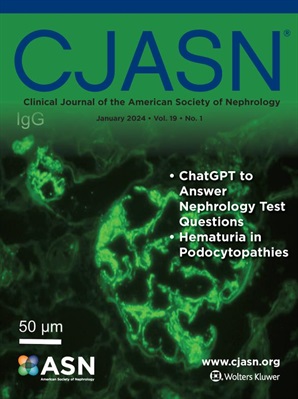住院期间急性肾损伤与邻里健康社会决定因素的关系
IF 8.5
1区 医学
Q1 UROLOGY & NEPHROLOGY
Clinical Journal of the American Society of Nephrology
Pub Date : 2024-09-11
DOI:10.2215/cjn.0000000000000528
引用次数: 0
摘要
化。方法:这是一项回顾性队列研究,研究对象是 2014 年 10 月至 2017 年 9 月期间入住美国南部大型医疗系统的无终末期肾病的成年人。邻里 SDOH 测量包括1) 社会经济状况:2)食物获取:3) 乡村性:3)农村性:农村城市通勤区(RUCA)得分;以及(4)居住隔离:差异和隔离得分。主要研究结果是根据血清肌酐(SCr)-KDIGO 标准得出的 AKI。我们的次要结果是缺乏 AKI 恢复(需要透析或出院时 SCr 升高)。采用广义估计方程模型评估了 SDOH 指标与 AKI 的相关性,并对人口统计学和临床特征进行了调整。结果显示在 26769 名患者中,有 26% 在住院期间发生了 AKI。与未发生 AKI 的患者相比,发生 AKI 的患者年龄较大(中位数为 60 岁对 57 岁),男性患者较多(55% 对 50%),自我认同为黑人的患者较多(38% 对 33%)。居住在最贫困社区(ADI 最高三分位数)的患者在住院期间发生 AKI 的调整后几率比居住在最不贫困地区(ADI 最低三分位数)的患者高 10%(95%CI:1.02-1.19)。居住在农村地区的患者在出院时出现 AKI 缺乏恢复的调整后几率要高出 25%(95%CI:1.07, 1.46)。食物获取和居住隔离与 AKI 的发生或恢复无关。结论来自社会经济条件最差社区和农村地区的住院病人在出院时发生 AKI 和 AKI 未痊愈的几率分别较高。需要更好地了解这些关联的内在机制,以便采取干预措施,降低弱势人群住院期间发生 AKI 的风险。版权所有 © 2024 年美国肾脏病学会...本文章由计算机程序翻译,如有差异,请以英文原文为准。
Association of Neighborhood Social Determinants of Health with Acute Kidney Injury during Hospitalization
lization. Methods: This is a retrospective cohort study of adults without end-stage kidney disease admitted to a large southern U.S. healthcare system from 10/2014 to 9/2017. Neighborhood SDOH measures included: 1) Socioeconomic status: Area Deprivation Index (ADI) scores, 2) Food access: Low Income Low Access (LILA) scores, 3) Rurality: Rural Urban Commuting Area (RUCA) scores, and (4) Residential segregation: dissimilarity and isolation scores. The primary study outcome was AKI based on serum creatinine (SCr)-KDIGO criteria. Our secondary outcome was lack of AKI recovery (requiring dialysis or elevated SCr at discharge). The association of SDOH measures with AKI was evaluated using generalized estimating equation models adjusted for demographics and clinical characteristics. Results: Among 26,769 patients, 26% developed AKI during hospitalization. Compared with those who did not develop AKI, those who developed AKI were older (median 60 vs. 57 years), more commonly men (55% vs. 50%), and more commonly self-identified as Black (38% vs. 33%). Patients residing in most disadvantaged neighborhoods (highest ADI tertile) had 10% (95%CI: 1.02-1.19) greater adjusted odds of developing AKI during hospitalization than counterparts in least disadvantaged areas (lowest ADI tertile). Patients living in rural areas had 25% higher adjusted odds of lack of AKI recovery by hospital discharge (95% CI: 1.07, 1.46). Food access and residential segregation were not associated with AKI development or recovery. Conclusions: Hospitalized patients from the most socioeconomically disadvantaged neighborhoods and from rural areas had higher odds of developing AKI and not recovering from AKI by hospital discharge, respectively. A better understanding of the mechanisms underlying these associations is needed to inform interventions to reduce AKI risk during hospitalization among disadvantaged populations. Copyright © 2024 by the American Society of Nephrology...
求助全文
通过发布文献求助,成功后即可免费获取论文全文。
去求助
来源期刊
CiteScore
12.20
自引率
3.10%
发文量
514
审稿时长
3-6 weeks
期刊介绍:
The Clinical Journal of the American Society of Nephrology strives to establish itself as the foremost authority in communicating and influencing advances in clinical nephrology by (1) swiftly and effectively disseminating pivotal developments in clinical and translational research in nephrology, encompassing innovations in research methods and care delivery; (2) providing context for these advances in relation to future research directions and patient care; and (3) becoming a key voice on issues with potential implications for the clinical practice of nephrology, particularly within the United States. Original manuscript topics cover a range of areas, including Acid/Base and Electrolyte Disorders, Acute Kidney Injury and ICU Nephrology, Chronic Kidney Disease, Clinical Nephrology, Cystic Kidney Disease, Diabetes and the Kidney, Genetics, Geriatric and Palliative Nephrology, Glomerular and Tubulointerstitial Diseases, Hypertension, Maintenance Dialysis, Mineral Metabolism, Nephrolithiasis, and Transplantation.

 求助内容:
求助内容: 应助结果提醒方式:
应助结果提醒方式:


